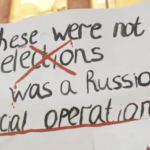Interest in the US presidential election in Slovakia is much greater this year than in the past. Key media have been paying attention for months and there have been several polls on this issue.
This is not only because of the United States’ importance for the country in the context of the transatlantic community, but also due to the turbulences in the international arena and the deterioration of the security situation in Europe.
Slovakia became part of the Euro-Atlantic family 20 years ago, when it joined the EU and NATO. The United States played a key role in its democratisation and integration into Western structures. In addition, Slovakia has many historical bonds with the country where the largest Slovak diaspora lives.
With Russia’s full-scale invasion of Ukraine in 2022, Slovakia, came into direct contact with a hot war in a neighboring country. Located on NATO’s eastern flank, it is also the target of intensive Russian hybrid operations.
Slovakia’s citizens realize that the United States is crucial for ending the war and bringing back a predictable international environment.
At the same time, they see that the US political scene is extremely polarized and unpredictable. The unprecedented attacks during the campaign raise concerns for Slovaks about the stability of the US political system and the capacity of the superpower to effectively engage on international issues in a time of multiple crises and increasing autocratic regimes.
In a September poll, 17 per cent of respondents said they were actively interested in the election and 44 per cent knew that it will take place. A quarter said that they were not interested and 15 per cent that they did not know that the United States will soon elect its president.
In the same poll, 59 per cent said they would opt for Kamala Harris and 41 per cent for Donald Trump if they were voters in the United States. Harris is popular especially among women, residents of the largest cities, and people with higher education. She mainly appeals to Slovakia’s liberal-democratic camp while Trump is popular among conservatives and nationalists.
A shared style of politics
Among voters of the three-member government coalition, Trump is the preferred candidate for those of Direction–Social Democracy (Smer–SD) and the Slovak National Party, while supporters of Voice–Social Democracy (Hlas–SD) are evenly divided between him and Harris.
On the opposition side, Trump finds considerable favor among the voters of the far-right Republika party. By contrast, enthusiasm for Harris is high among the voters of Progressive Slovakia, Freedom and Solidarity (SaS), the Christian Democratic Movement (KDH), and the Democrats. Supporters of the Slovakia movement are evenly divided between the two candidates.
Smer–SD’s Robert Fico, who became prime minister for the fourth time a year ago, recently said: “I think that if Donald Trump is elected, there is a higher probability of ending the conflict” in Ukraine.
When he was previously prime minister, Fico supported Trump in his 2016 campaign for the White House. In this regard, he is like Hungary’s Viktor Orbán, who has been openly sympathetic to Trump for a long time.
The support of Fico and his coalition partners for Trump is related not only to the war in Ukraine, but also to a shared style of politics that emphasises a strong state, a strong leader, and transactional interests in foreign policy.
Security
The development of the security situation—in particular, the course and possible end of the war—will have a major impact on Slovak-US relations. In recent years, Slovakia has increasingly focused on security cooperation with the United States.
In 2018, it signed a 1.8 billion US dollars deal to purchase 14 US F-16 fighter jets, and in July it took possession of the first two jets. (The rest will be gradually delivered over the next two years). The F-16s will significantly increase Slovakia’s defence capabilities. In February 2022, the two countries signed a Defence Cooperation Agreement (DCA).
Fico’s government could be in office for most of the next US presidential term as the next parliamentary elections are not due before 2027. Given Washington’s importance as a strategic security and economic partner, the government will very likely continue to strive to maintain this partnership regardless of who occupies the White House.
Despite Fico’s strong pre-election opposition to the DCA and continuous anti-US rhetoric, his government is adhering to the agreement. So far, it seems that, despite his political opportunism and Russophile talk, he grudgingly accepts that the best alignment for the sovereignty of a small country like Slovakia is within US-led NATO.
Meanwhile, President Peter Pellegrini, who is only six months into his five-year term, is trying not to alienate US-sceptical voters but has quite obvious pro-West instincts. He will most likely advocate a transatlanticist policy.
Alignment, not rhetoric
No matter who wins the US election, Washington will judge Slovakia’s government, and most others in Europe, not on its rhetoric, but on how much it aligns itself with the next administration’s security and economic policies as well as on how much it fulfills its obligations in Euro-Atlantic structures.
If Trump is elected, the US attitude toward countries like Slovakia will likely be especially transactional, with values and human rights less prominent in the relationship.
And, given that Slovakia is not likely to get much attention from the president, much will depend on who Trump picks for his secretaries of state and defence and his national security advisor.
If Harris wins, US policy in Europe could be quite similar to that during the Biden administration, with adherence to liberal-democratic values taken into consideration when dealing with the leaders and governments of different countries.
In Central and Eastern Europe, this was seen in Washington’s dealings with Hungary over the last three years, and it could bring more of a US spotlight on the domestic political situation and the government in Slovakia.
This article is part of series in which German Marshall Fund of the United States (GMF) experts from Central and Eastern Europe set out the implications of a Harris or Trump win in the US presidential election for the countries in the region.







